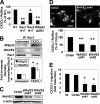Syk regulates multiple signaling pathways leading to CX3CL1 chemotaxis in macrophages
- PMID: 21388954
- PMCID: PMC3083178
- DOI: 10.1074/jbc.M110.185181
Syk regulates multiple signaling pathways leading to CX3CL1 chemotaxis in macrophages
Abstract
Several studies have clearly established the importance of the interaction between macrophages and CX3CL1 in the progression of disease. A previous study demonstrated that Syk was required for CX3CL1-mediated actin polymerization and chemotaxis. Here, we delineated the signaling cascade of Syk-mediated cell migration in response to CX3CL1. Inhibition of Syk in bone marrow-derived macrophages or reduction of Syk expression using siRNA in RAW/LR5 cells indicated that Syk was required for the activation of PI3K, Cdc42, and Rac1. Also, reduction in WASP or WAVE2 levels, common downstream effectors of Cdc42 or Rac1, resulted in impaired cell migration to CX3CL1. Syk indirectly regulated WASP tyrosine phosphorylation through Cdc42 activation. Altogether, our data identify that Syk mediated chemotaxis toward CX3CL1 by regulating both Rac1/WAVE2 and Cdc42/WASP pathways, whereas Src family kinases were required for proper WASP tyrosine phosphorylation.
Figures






Similar articles
-
The chemotactic defect in wiskott-Aldrich syndrome macrophages is due to the reduced persistence of directional protrusions.PLoS One. 2012;7(1):e30033. doi: 10.1371/journal.pone.0030033. Epub 2012 Jan 18. PLoS One. 2012. PMID: 22279563 Free PMC article.
-
Syk is required for monocyte/macrophage chemotaxis to CX3CL1 (Fractalkine).J Immunol. 2005 Sep 15;175(6):3737-45. doi: 10.4049/jimmunol.175.6.3737. J Immunol. 2005. PMID: 16148119
-
Cdc42 regulates Fc gamma receptor-mediated phagocytosis through the activation and phosphorylation of Wiskott-Aldrich syndrome protein (WASP) and neural-WASP.Mol Biol Cell. 2009 Nov;20(21):4500-8. doi: 10.1091/mbc.e09-03-0230. Epub 2009 Sep 9. Mol Biol Cell. 2009. PMID: 19741094 Free PMC article.
-
Membrane targeting of WAVE2 is not sufficient for WAVE2-dependent actin polymerization: a role for IRSp53 in mediating the interaction between Rac and WAVE2.J Cell Sci. 2008 Feb 1;121(Pt 3):379-90. doi: 10.1242/jcs.010272. Epub 2008 Jan 15. J Cell Sci. 2008. PMID: 18198193 Free PMC article.
-
Wiskott-Aldrich syndrome: a disorder of haematopoietic cytoskeletal regulation.Microsc Res Tech. 1999 Oct 15;47(2):107-13. doi: 10.1002/(SICI)1097-0029(19991015)47:2<107::AID-JEMT3>3.0.CO;2-H. Microsc Res Tech. 1999. PMID: 10523789 Review.
Cited by
-
Apocynum Leaf Extract Suppresses the Progress of Atherosclerosis in Rats via the FKN/SYK/p38 Signal Pathway.Evid Based Complement Alternat Med. 2021 Nov 3;2021:5524226. doi: 10.1155/2021/5524226. eCollection 2021. Evid Based Complement Alternat Med. 2021. PMID: 34777534 Free PMC article.
-
Macrophage Syk-PI3Kγ Inhibits Antitumor Immunity: SRX3207, a Novel Dual Syk-PI3K Inhibitory Chemotype Relieves Tumor Immunosuppression.Mol Cancer Ther. 2020 Mar;19(3):755-764. doi: 10.1158/1535-7163.MCT-19-0947. Epub 2020 Jan 23. Mol Cancer Ther. 2020. PMID: 31974273 Free PMC article.
-
Identification of new drugs to counteract anti-spike IgG-induced hyperinflammation in severe COVID-19.Life Sci Alliance. 2023 Sep 12;6(11):e202302106. doi: 10.26508/lsa.202302106. Print 2023 Nov. Life Sci Alliance. 2023. PMID: 37699657 Free PMC article.
-
Cryptococcus neoformans Induces MCP-1 Release and Delays the Death of Human Mast Cells.Front Cell Infect Microbiol. 2019 Aug 13;9:289. doi: 10.3389/fcimb.2019.00289. eCollection 2019. Front Cell Infect Microbiol. 2019. PMID: 31456952 Free PMC article.
-
Two-dimensional motility of a macrophage cell line on microcontact-printed fibronectin.Cytoskeleton (Hoboken). 2014 Sep;71(9):542-54. doi: 10.1002/cm.21191. Epub 2014 Oct 3. Cytoskeleton (Hoboken). 2014. PMID: 25186818 Free PMC article.
References
-
- Cambien B., Pomeranz M., Schmid-Antomarchi H., Millet M. A., Breittmayer V., Rossi B., Schmid-Alliana A. (2001) Blood 97, 2031–2037 - PubMed
-
- Umehara H., Bloom E. T., Okazaki T., Nagano Y., Yoshie O., Imai T. (2004) Arterioscler. Thromb. Vasc. Biol. 24, 34–40 - PubMed
-
- Imai T., Hieshima K., Haskell C., Baba M., Nagira M., Nishimura M., Kakizaki M., Takagi S., Nomiyama H., Schall T. J., Yoshie O. (1997) Cell 91, 521–530 - PubMed
-
- Goda S., Imai T., Yoshie O., Yoneda O., Inoue H., Nagano Y., Okazaki T., Imai H., Bloom E. T., Domae N., Umehara H. (2000) J. Immunol. 164, 4313–4320 - PubMed
-
- Ruth J. H., Volin M. V., Haines G. K., 3rd, Woodruff D. C., Katschke K. J., Jr., Woods J. M., Park C. C., Morel J. C., Koch A. E. (2001) Arthritis Rheum. 44, 1568–1581 - PubMed
Publication types
MeSH terms
Substances
Grants and funding
LinkOut - more resources
Full Text Sources
Research Materials
Miscellaneous

